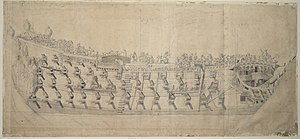
HMS Duke was a 90-gun second-rate ship of the line of the Royal Navy, launched on 13 June 1682 at Woolwich Dockyard.

HMS Royal Charles was a 100-gun first-rate ship of the line of the Royal Navy, designed and built by Sir Anthony Deane at Portsmouth Dockyard, where she was launched and completed by his successor as Master Shipwright, Daniel Furzer, in March 1673. She was one of only three Royal Navy ships to be equipped with the Rupertinoe naval gun.

HMS London was a 96-gun first-rate ship of the line of the Royal Navy, built by Christopher Pett at Deptford Dockyard until his death in March 1668, and completed by Jonas Shish and launched in 1670.

HMS St Andrew was a 96-gun first-rate ship of the line of the Royal Navy, built by Christopher Pett at Woolwich Dockyard under the supervision of Christopher Pett until his death in March 1668, completed by Jonas Shish, and launched in 1670. Commanded by George Churchill, she took part in the 1692 victory over the French navy at Barfleur & La Hogue.

HMS Royal James was a 100-gun first-rate ship of the line of the Royal Navy, designed by Sir Anthony Deane and built by his successor as Master Shipwright at Portsmouth Dockyard, Daniel Furzer, and launched in 1675. She was renamed HMS Victory on 7 March 1691 after the old second rate Victory of 1666 was condemned by survey and taken to pieces. Recommissioned in January 1691 under Captain Edward Stanley, as the flagship of Admiral Sir John Ashby she participated in the Battle of Barfleur on 19 May 1692 – 24 May 1692.
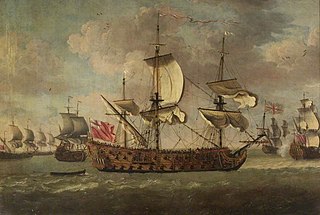
HMS Swiftsure was a 70-gun third-rate ship of the line of the Royal Navy, built by Sir Anthony Deane at Harwich, and launched in 1673. By 1685 she had been reduced to a 66-gun ship.
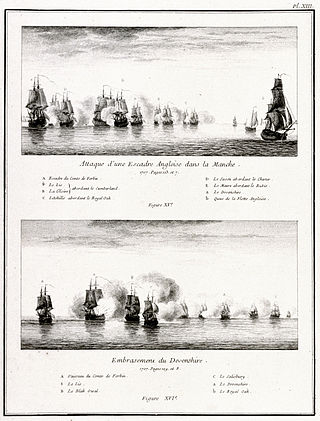
HMS Salisbury was a 50-gun fourth rate ship of the line of the Royal Navy, built by Richard and James Herring at Baileys Hard on the Beaulieu River in Hampshire, England, and launched on 18 April 1698.

HMS Lenox was a 70-gun third rate built at Deptford Dockyard in 1677/78. She was in active commission for the War of English Succession fighting in the Battles of Beachy Head and Barfleur. She was rebuilt in 1699. Again in active commission for the War of Spanish Succession fighting in the Capture of Gibraltar and the Battle of Velez Malaga. She followed this with the Battle off Passero. She was rebuilt again in 1721. She was active in the War with Spain, capturing the Princesa then serving in Home Waters, the Mediterranean and finally the West Indies. She was in action off Havana in 1745. She returned home and was placed in Ordinary. She was finally sunk as a breakwater at Sheerness in 1756.

HMS Eagle was a 70-gun third rate ship of the line of the Royal Navy, built at Portsmouth Dockyard during 1677/79. When completed she was placed in Ordinary for 10 years. She was in active commission during the War of the English Succession partaking in the Battle of Barfleur. She was rebuilt in 1699 at Chatham. She again played an active role in the early part of the War of Spanish Succession participating in the Capture of Gibraltar, and the Battle of Velez Malaga. She was wrecked in the Isles of Scilly in October 1707.

HMS Suffolk was a 70-gun third-rate ship of the line of the Royal Navy, built by contract of 20 February 1678 by Sir Henry Johnson at Blackwall. She participated in the War of the English Succession 1689 - 1697, in the Battles of Beachy Head and Barfleur. She was rebuilt in 1699. She was actively involved in the War of Spanish Succession 1702 - 1713. Her later career was as guard ship duties, deployments to the Baltic Sea and the West Indies. She was finally broken in 1765 after lying in Ordinary for almost twenty years.

HMS Lancaster was an 80-gun third rate ship of the line of the Royal Navy, launched at Bursledon on 3 April 1694.

HMS Canterbury was a 60-gun fourth-rate ship of the line of the Royal Navy, launched at Deptford on 18 December 1693.
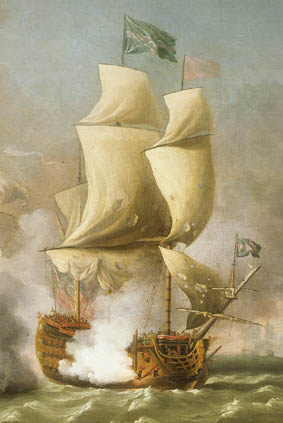
HMS Barfleur was a 90-gun second rate ship of the line of the Royal Navy, launched at Deptford Dockyard on 10 August 1697.
HMS Triumph was a 90-gun second rate ship of the line of the Royal Navy, launched at Chatham Dockyard on 2 March 1697. She was renamed HMS Prince in 1714.
HMS Falmouth was a 50-gun fourth-rate ship of the line built for the Royal Navy in the first decade of the 18th century. The ship participated in several battles during the War of the Spanish Succession (1701–15) and the War of Jenkins' Ear (1739–48).

HMS Gloucester was a 50-gun fourth-rate ship of the line built at Deptford by Joseph Allin the elder for the Royal Navy in 1710/11. She participated in the War of the Spanish Succession. The ship was burned to prevent capture after she was damaged in a storm during Commodore George Anson's voyage around the world in 1742.
HMS Phoenix was built as a fireship as part of the 1693–94 programme of Fireships. After her commissioning she spent time in the English Channel then joined the Fleet for the Battle of Vigo Bay followed by the Battle of Velez-Malaga. She went aground in the Isles of Scilly and was salvaged. While laid up at Plymouth in 1708 was rebuilt as a 24-gun sixth rate. After recommissioning she spent her time in Home Waters, North America and the West Indies. She was rebuilt again in 1727 before finally being sold in 1744.
HMS Nonsuch was a 36-gun fifth rate of the Royal Navy. She was an experimental fast-sailing design, built by the renowned shipwright Anthony Deane according to proposals by the Dutch naval officer Laurens van Heemskirk, who became her first captain. She was launched in December 1668, and commissioned the same day under van Heemskirk. In 1669 she was reclassed as a 42-gun Fourth rate, being commanded from 9 April by Captain Sir John Holmes. She was to spend most of her career in the Mediterranean. She was for a time based on Tangier, and was commanded by a succession of accomplished commanders who subsequently rose to flag rank in the Navy, including George Rooke from 1677 to 1680, then briefly under Cloudesley Shovell, and then Francis Wheler from 1680 to 1681. Under Wheler's command, she participated on 9 April 1681 in the capture of the Algerine 46-gun Golden Horse, along with the Fourth rate Adventure.
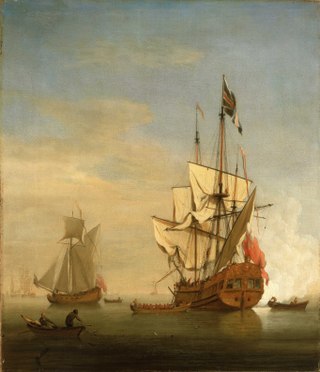
HMS Peregrine Galley was a 20-gun sixth-rate ship of the Royal Navy, built in 1699-1700 at Sheerness Dockyard by Master Shipwright William Lee to a design by Rear-Admiral the Marquis of Carmarthen. She was generally employed as a Royal yacht and in 1716 she was officially renamed HMS Carolina and converted to a permanent Royal yacht. In May 1733 she was rebuilt by Richard Storey at Deptford Dockyard as the Royal yacht and again renamed, this time as Royal Caroline. In 1739 she ceased to be the Royal yacht and resumed her classification as a Sixth Rate. In 1749 a new Royal Caroline was built to replace her. She reverted to being a naval sloop under the name HMS Peregrine and served until her loss on or about 28 December 1761.
HMS Lyme was a 32-gun fifth rate built by Mr. Flint of Plymouth in 1694/95. She spent her career on counter piracy patrols and trade protection duties in Home Waters, the Mediterranean and in North America and the West Indies. She was rebuilt to the 1719 Establishment as a sixth rate in 1720/21. Her breaking was completed in January 1739.
